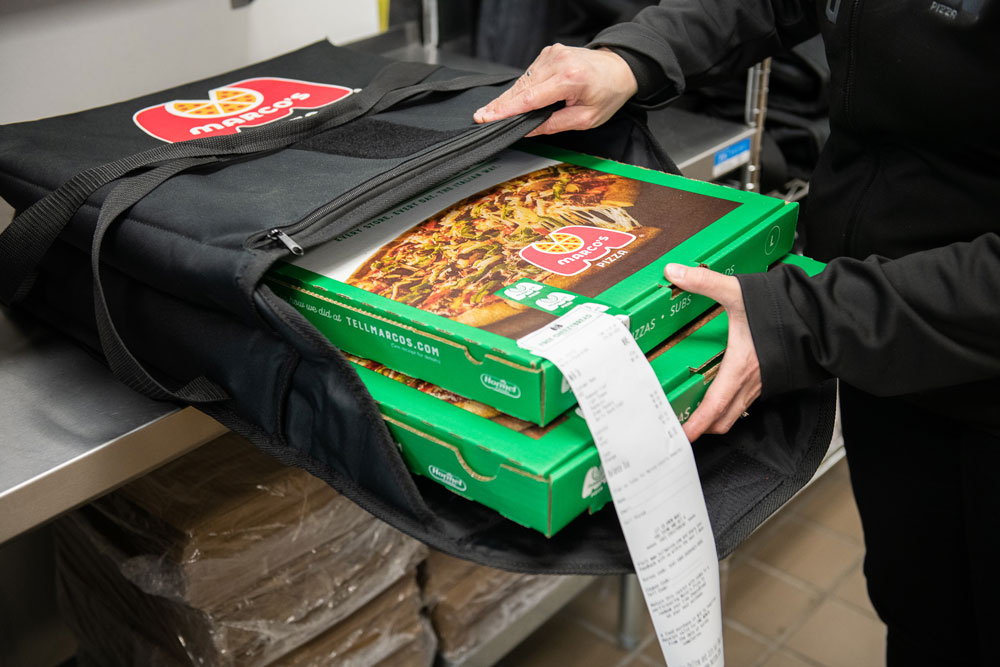- In an industry long dominated by men, it was a woman who solved the problem of delivering soggy pizza.
- Today, possibilities include thermal-insulated, disk-heated, induction-heated and internally heated hot bags.
By Rick Hynum
Like all of the great inventors, Ingrid Kosar identified a need and figured out a way to fulfill it. Specifically, as she wrote in her patent application for the first thermal bag, “There is a need in certain fields for soft-sided, thermally insulated carrying cases. One particular application is the ready-to-eat pizza field, where hot pies are packaged in rectangular cardboard cartons and delivered several cartons at a time to customers’ homes or offices.”
Customers have always wanted their delivered pizza to taste like it’s still fresh out of the oven, not cold and soggy. Cardboard alone couldn’t do the trick. So, in an industry long dominated by men, it was a woman from Des Plaines, Illinois, who stepped up with the solution.
Since then, numerous other rival products have sprung up, and hot bags have become ubiquitous in the pizza industry. But with so many choices and price ranges to choose from, how do you decide which hot bags are best for you? Like any other piece of equipment, it depends on your type of pizza operation. Do you cover a wide delivery range, or are all of your deliveries within a 10-minute drive? Do you live in an area of the country with bitterly cold winters or in a relatively warm Southern state? Do your drivers have to deliver multiple orders at once, or are they primarily single- or double-delivery runs? How many bags will you need to equip all of your drivers? We can’t answer these questions for you, but we can give you a few tips, compiled from interviews with industry experts over the years, to help you decide for yourself.
Related: How independent pizzerias and local restaurant delivery services can join forces
Know your options. The possibilities include thermal-insulated, disk-heated, induction-heated and internally heated hot bags. Thermal-insulated bags, which simply retain the heat from the pizza, are the most commonly used type because they’re highly affordable and do a perfectly adequate job of keeping the average pizza—one delivered within 30 minutes—hot. If you choose a bag with a heating element, keep in mind that the elements usually take between 10 and 15 minutes to warm up and typically retain heat well for about a half-hour. This type of bag is often used for event catering or for situations that require a lot of deliveries—or long-distance travel—in a single run. For insulated bags, look for one with moisture-free insulation and lining to prevent sogginess. Choose a bag that’s close in size to your pizza boxes—if there’s too much extra space, the pizza might shift around in the box during the drive or fail to make full contact with all of the internal heating elements.
Find the right mix of bag sizes. Your bags should be flexible enough to carry various delivery items, such as wings and other sides as well as pizzas. Bags in the 14” size rank among the most popular, but other sizes include 2-16”, 3-16”, 3-18” and 2-20”. If you offer cold items for delivery, such as sandwiches or desserts, deliver them in separate bags. A good rule of thumb: Stock two bags for each delivery driver on your team, plus two larger bags that can hold six to 10 pizza boxes. If you have a catering service, you’ll definitely want larger bags that can accommodate 10 pies. In general, make sure you know the number of pizzas in a typical delivery order, and use that as a guide for determining bag sizes.
Related: Why the personal touch beats third-party delivery every time
Treat your bags right. A good hot bag can last up to two years, but you’ll want to extend that life as long as possible. For starters, look for bags that have a sturdy construction, well-sewn handles and straps, and stain-resistant fabric. Then make sure to clean them at least once every six months. Keep in mind that most manufacturers warn against running hot bags through a washing machine—that can damage the insulation. Instead, wash soft-sided bags by hand in the sink with warm water and a mild disinfectant/detergent. Scrub them down inside and out and hang them up to dry overnight. Remember that some bags can be tricky to clean, depending on their size, materials, padding and heat sources. Make sure you know how to clean your bags before you buy them.
Know when to box and bag your pies. If you work with a conveyor oven, let the pizza sit at the end of the conveyor for as long as possible. Once it goes into the box and then the bag, it can start steaming and lose its crispness or begin to cool down. This is especially true with veggie-heavy pizzas, because vegetables release a lot of moisture. Note: If you use bags with internal heaters or disks, make sure all of your drivers know it’s important to keep them plugged in or the hot disks properly inserted. Make it a routine task to recharge them when opening the store every day.
Rick Hynum is PMQ’s editor in chief.














